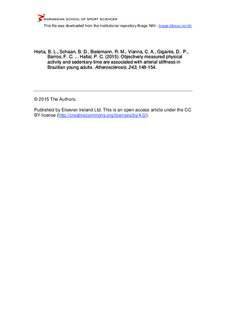| dc.contributor.author | Horta, Bernardo L. | |
| dc.contributor.author | Schaan, Beatriz D. | |
| dc.contributor.author | Bielemann, Renata M. | |
| dc.contributor.author | Vianna, Carolina Avila | |
| dc.contributor.author | Gigante, D. Petrucci | |
| dc.contributor.author | Fernando, C. | |
| dc.contributor.author | Ekelund, Ulf | |
| dc.contributor.author | Hallal, Pedro C. | |
| dc.date.accessioned | 2016-02-18T09:10:28Z | |
| dc.date.available | 2016-02-18T09:10:28Z | |
| dc.date.issued | 2015-11 | |
| dc.identifier.citation | Atherosclerosis. 2015, 243,148–154. doi:10.1016/j.atherosclerosis.2015.09.005 | nb_NO |
| dc.identifier.uri | http://hdl.handle.net/11250/2379460 | |
| dc.description | Open Access funded by Wellcome Trust.
Under a Creative Commons license. | nb_NO |
| dc.description.abstract | Objective:
To examine the associations between objectively measured physical activity and sedentary time with pulse wave velocity (PWV) in Brazilian young adults.
Methods:
Cross-sectional analysis with participants of the 1982 Pelotas (Brazil) Birth Cohort who were followed-up from birth to 30 years of age. Overall physical activity (PA) assessed as the average acceleration (mg), time spent in moderate-to-vigorous physical activity (MVPA – min/day) and sedentary time (min/day) were calculated from acceleration data. Carotid-femoral PWV (m/s) was assessed using a portable ultrasound. Systolic and diastolic blood pressure (SBP/DBP), waist circumference (WC) and body mass index (BMI) were analyzed as possible mediators. Multiple linear regression and g-computation formula were used in the analyses.
Results:
Complete data were available for 1241 individuals. PWV was significantly lower in the two highest quartiles of overall PA (0.26 m/s) compared with the lowest quartile. Participants in the highest quartile of sedentary time had 0.39 m/s higher PWV (95%CI: 0.20; 0.57) than those in the lowest quartile. Individuals achieving ≥30 min/day in MVPA had lower PWV (β = −0.35; 95%CI: −0.56; −0.14). Mutually adjusted analyses between MVPA and sedentary time and PWV changed the coefficients, although results from sedentary time remained more consistent. WC captured 44% of the association between MVPA and PWV. DBP explained 46% of the association between acceleration and PWV.
Conclusions:
Physical activity was inversely related to PWV in young adults, whereas sedentary time was positively associated.
Such associations were only partially mediated by WC and DBP. | nb_NO |
| dc.language.iso | eng | nb_NO |
| dc.publisher | Elsevier | nb_NO |
| dc.subject | vascular stiffness | nb_NO |
| dc.subject | physical activity | nb_NO |
| dc.subject | cohort studies | nb_NO |
| dc.title | Objectively measured physical activity and sedentary-time are associated with arterial stiffness in brazilian young adults | nb_NO |
| dc.type | Journal article | nb_NO |
| dc.type | Peer reviewed | nb_NO |
| dc.subject.nsi | VDP::Medical disciplines: 700 | nb_NO |
| dc.source.journal | Atherosclerosis | nb_NO |
| dc.description.localcode | Seksjon for idrettsmedisinske fag / Department of Sports Medicine | nb_NO |
